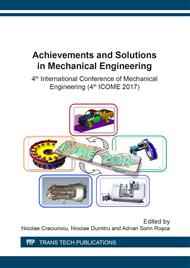p.27
p.33
p.39
p.45
p.53
p.63
p.69
p.75
p.81
The NASGRO Method - Comparison Model for the Crack Growth Rate Calculus
Abstract:
The products materials failure process subjected to a time variable loading can be watched and controlled through the study of an important parameter from the “Fracture Mechanics” given by the crack growth rate or the cracking rate. This is marked with da/dN, sometimes da/dt, representing the length variation a at a fatigue loading cycle. From the most used models for its study, one can remember: methods that use the American standards ASTM, Paris formula model or the Walker one. The model called NASGRO or FNK is used to study the crack growth evolution in NASA studies, being a more complex method, for the cracking process. The results obtained were compared to the ones determined with the above methods. For the tests, steel samples R520 were used, CT type, with side notch. The loading cycle was made with the asymmetry coefficient R= 0.5, at the temperatures: 293K, 252K and 213K.
Info:
Periodical:
Pages:
53-62
Citation:
Online since:
March 2018
Authors:
Keywords:
Price:
Сopyright:
© 2018 Trans Tech Publications Ltd. All Rights Reserved
Share:
Citation:


